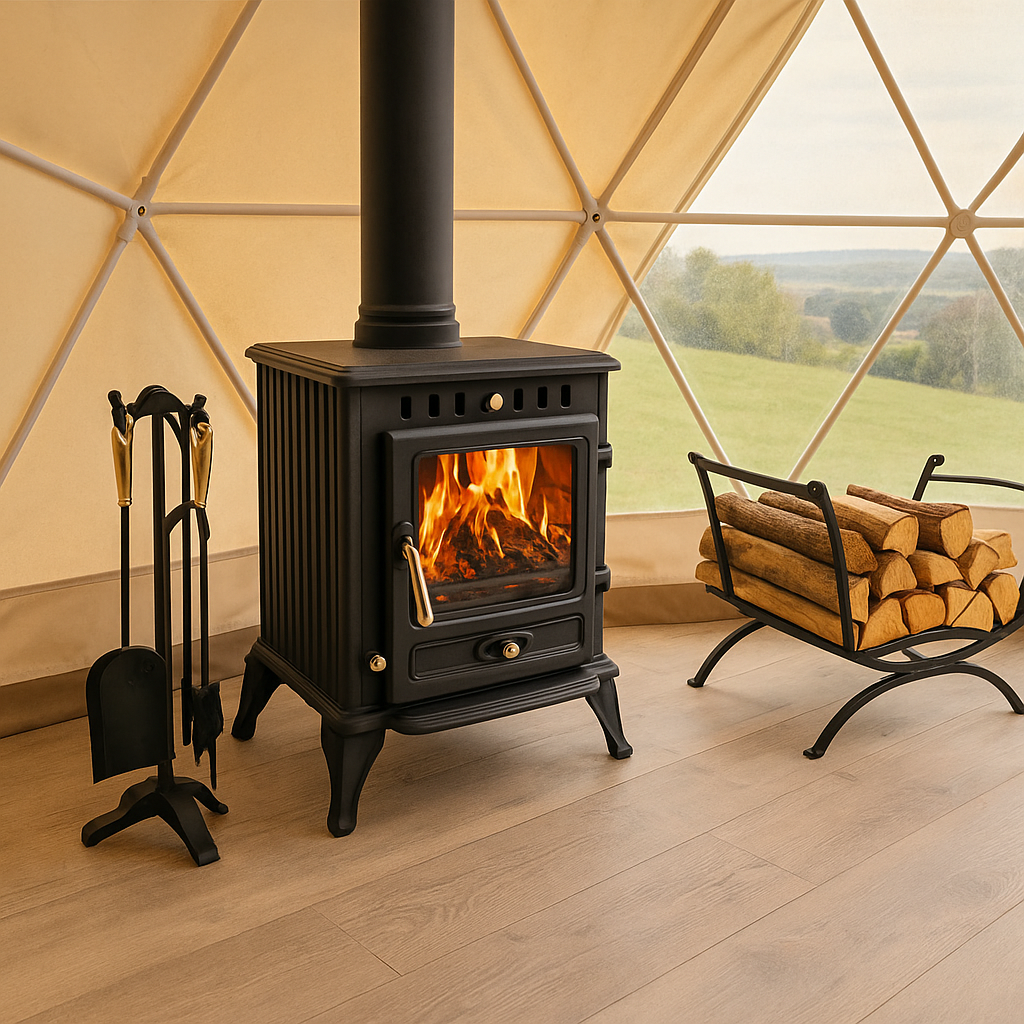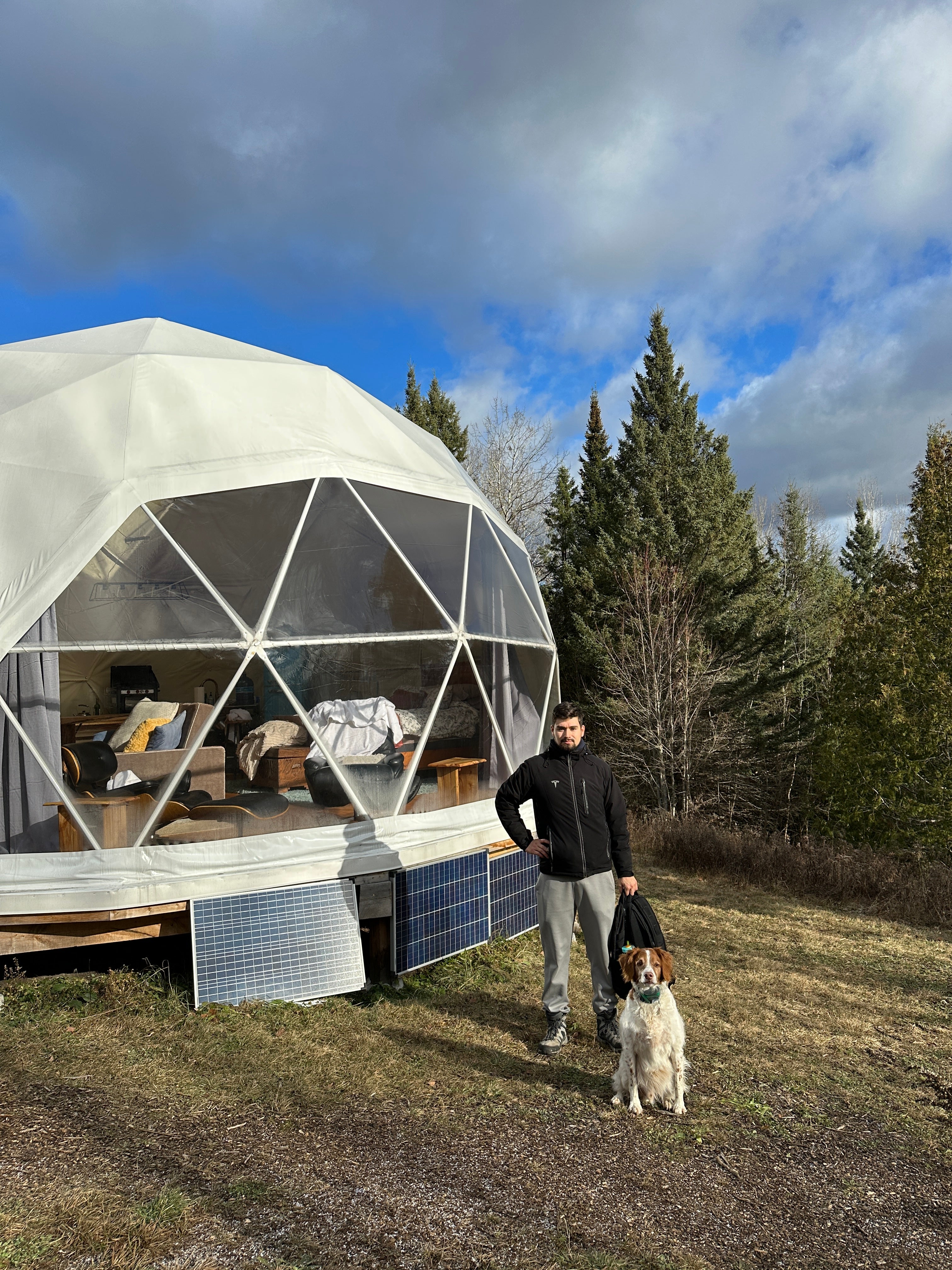Geodesic glamping domes offer a magical off-grid experience—but they need proper heating to stay comfortable in colder weather. If you're wondering what’s the best way to heat your glamping dome, you're not alone.
From rustic charm to energy-efficient technology, here are 7 proven methods to heat your dome for year-round comfort.
1. Wood Stove
Wood stoves are a classic and reliable way to heat your glamping dome. They're ideal for off-grid setups and provide cozy, radiant warmth.
Pros:
- Off-grid compatible
- High heat output
- Rustic, cozy, authentic atmosphere
- Can double as a cooking surface in emergencies
- Readily available fuel in many areas
Cons:
- Requires a chimney/flue installation
- Needs regular cleaning and maintenance
- Firewood storage and hauling can be labor-intensive
- No thermostat or temperature control
Best for: Remote locations, off-grid living, and guests seeking a rustic, back-to-nature experience.
2. Wood Pellet Stove
Pellet stoves offer the warmth of wood with greater efficiency and less maintenance.
Pros:
- Highly efficient and clean-burning
- Burns longer with less refueling than wood stoves
- Easier temperature control with thermostats and timers
- Pellets are compact and easier to store
Cons:
- Requires electricity to operate
- More complex installation and maintenance
- Pellets may be harder to source locally than firewood
- Higher upfront cost than a basic wood stove
Best for: Semi-off-grid setups with solar or generator backup, and dome sites where environmental impact is a concern.
3. Electric Space Heater
A convenient and plug-and-play option. Modern electric heaters are compact and available with safety features like auto shut-off, timers, and thermostats.
Pros:
- Easiest to install use and move
- No emissions or ventilation needed
- Instant heat with thermostat control
- Low maintenance
- Affordable upfront
Cons:
- Requires a stable power source
- High energy consumption can drive up operating costs
- Not suitable for off-grid locations without ample solar/battery capacity
- Not ideal for sustained cold weather
Best for: Domes connected to the grid or those with strong renewable energy systems.
4. Propane Heater
Portable propane heaters are a flexible choice, especially for remote or off-grid locations where firewood isn’t practical.
Pros:
- Portable and fast heating
- No electricity needed (for some models)
- Propane is widely available
Cons:
- Requires proper ventilation to prevent carbon monoxide buildup
- Fuel costs can add up
- Tanks must be stored and handled with care
Best for: Short-term stays or backup heating in off-grid setups.
5. Radiant Floor Heating (Electric or Hydronic)
Radiant floor systems provide even, long-lasting warmth from the ground up. They’re often used in luxury dome setups.
Pros:
- Even, silent, consistent and invisible heating
- No airflow or dust circulation
- High-end comfort and energy efficiency
- Works well with insulation
Cons:
- Expensive to install
- Requires professional setup
- Slow to heat and not suitable for quick warm-ups
Best for: Permanent or high-end glamping installations where guests expect premium comfort.
6. Heat Recovery Ventilator (HRV) or Energy Recovery Ventilator (ERV)
While not a primary heat source, air exchangers (HRVs and ERVs) are essential in well-insulated domes to maintain indoor air quality without sacrificing warmth. These systems bring in fresh outdoor air while recovering heat from outgoing stale air.
Pros:
- Maintains air quality and brings fresh air in airtight domes
- Recovers up to 85% of heat from exhausted air
- Helps control humidity and prevent condensation
- Operates quietly and efficiently
Cons:
- Requires ducting and installation planning
- Doesn’t provide standalone heat—must be paired with another system
- Needs regular filter changes and maintenance
Best for: Highly insulated domes in colder climates, especially those occupied full-time or for extended stays.
7. Mini Split Heat Pump (Air Source)
Mini split systems offer both heating and cooling using heat pump technology. They are quiet, efficient, and excellent for domes with reliable electricity or solar setups.
Pros:
- Dual function: heating in winter, cooling in summer
- Highly efficient (up to 300% efficiency rating)
- Precise temperature control
- Wall-mounted units take up little space
- Low maintenance and long lifespan
Cons:
- Requires electricity to operate
- Higher initial cost
- May lose efficiency in extremely cold temperatures (unless rated for cold climates)
Best for: Grid-connected domes or high-end off-grid domes with solar + battery systems.
Final Thoughts
The best way to heat your glamping dome depends on your location, budget, and off-grid capabilities. For many dome owners, the ideal setup is a hybrid system—like a wood stove for charm and backup power, paired with a mini split or radiant floor for efficiency.
Don’t overlook insulation and ventilation. Systems like HRVs/ERVs not only improve air quality but also reduce the energy load on your main heat source, making your dome cozier and more cost-effective all year long.


